The word “bungalow” may seem today like a synonym for cottage, but in its heyday it was prized both for its exotic, Anglo–Indian associations and its artistic naturalism.
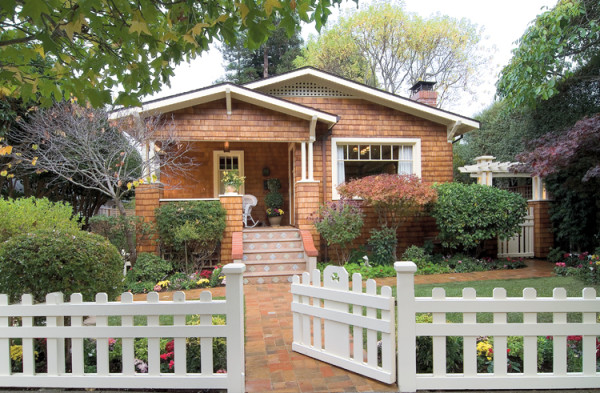
A bungalow nestles into its site, low and spreading. It was inevitable that the form would be embraced by tastemakers and builders of the Arts & Crafts movement. The architects Greene and Greene in California called their millionaires’ chalets bungalows. Gustav Stickley sang their praises in this magazine The Craftsman. Dozens of planbooks between 1909 and 1925 promoted “artistic bungalows.” Only later, with the ascendancy of a middle-class Colonial Revival, did Arts & Crafts ideals lose favor and bungalow become a derogatory label.
The bungalow as a house form has close ties to the Arts & Crafts movement—and an even stronger affinity today, as thousands of bungalows, some quite modest, are snatched up to be interpreted in a manner that’s often beyond the tastes and budgets of the original owners.
Hallmarks of the Arts & Crafts Bungalow
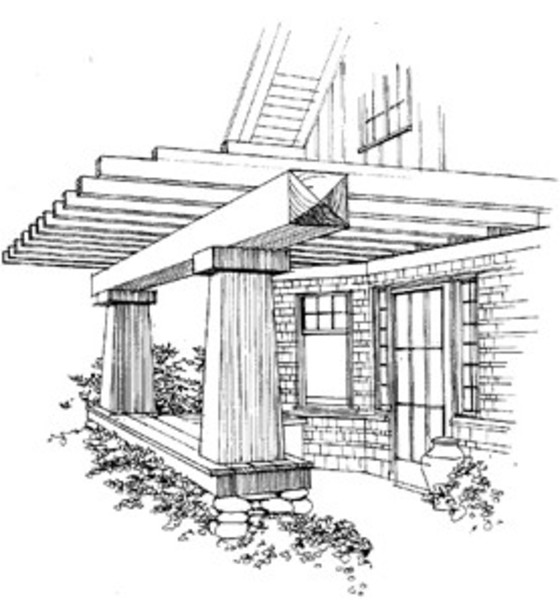
(Illustrations: Rob Leanna)
ARTISTIC NATURALISM Most bungalows are low and spreading, not more than a story-and-a-half tall, with porches, sun porches, pergolas and patios tying them to the outdoors. The A&C bungalow follows an informal aesthetic; it is an artistic house without strong allusions to formal English or classical precedents.
INDIGENOUS MATERIALS An artistic use of such materials as river rock, clinker brick, quarried stone, shingles, and stucco is common.
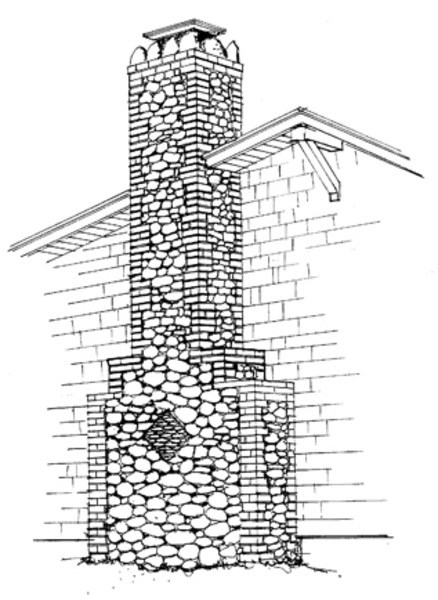
EMPHASIS ON STRUCTURE Look for artistic exaggeration in columns, posts, eaves brackets, lintels, and rafters. Inside, too, you’ll find ceiling beams, chunky window trim, and wide paneled doors.
Bungalow Variants
Period bungalows can be quite plain little houses, too, or nod to other styles including English Tudor, Prairie School, and, anachronistically, Colonial.
Inside the Bungalow
The typical bungalow interior, at least as it was presented in the house books of the period, is easy to recognize. Basically, the bungalow interior was a Craftsman interior.
In a complete departure from Victorian interior decoration, bungalow writers frowned on the display of wealth and costly collectibles. Rather than buying objects of obvious or ascribed value, the homeowner was told to look for simplicity and craftsmanship: “A luxury of taste substituting for a luxury of cost.”
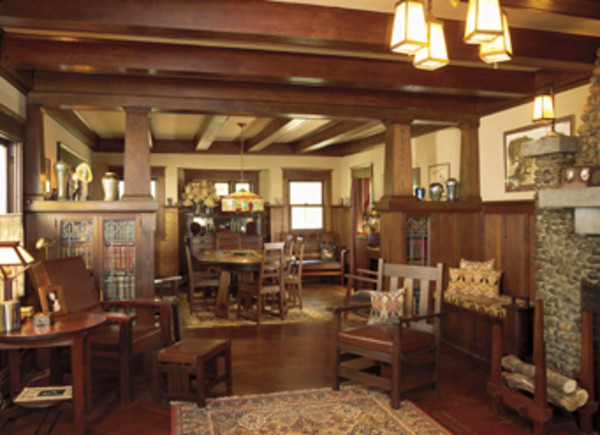
(Photo: Gross & Daley)
Keep in mind that both Greene and Greene’s Gamble House in Pasadena and a three-room vacation shack without plumbing were called bungalows. And they both affected what the typical year-round bungalow would look like. The finest examples of Arts & Crafts handiwork found a place in the bungalow, as did rustic furniture.
Walls were often wood-paneled to chair-rail or plate-rail height. Burlap in soft earth tones was suggested for the wall area above, or used in wood-battened panels where paneling was absent. Landscape friezes and abstract stenciling above a plate rail were often pictured. Dulled, grayed shades and earth tones, even pastels, were preferred to strong colors. Plaster with sand in the finish coast was suggested. Woodwork could be golden oak or oak brown-stained to simulate old English woodwork, or stained dull black or bronze green. Painted softwood was also becoming popular, especially for bedroom, with white enamel common before 1910 and stronger color gaining popularity during the ’20s.
It became almost an obsession with bungalow builders to see how many amenities could be crammed into the least amount of space. By 1920, the bungalow had more space-saving built-ins than a yacht: Murphy wall beds, ironing boards in cupboards, built-in mailboxes, telephone nooks.
Writers advocated the “harmonious use” of furnishings small and few. Oak woodwork demanded oak furniture, supplemented with reed, rattan, wicker, or willow in natural, gray, or pastels. Mahogany pieces were thought best against a backdrop of woodwork painted white. (Bright white was used most often for bathroom trim; “white” could also signify cream, yellow, ivory, or pale gray.) A large table with a reading lamp was the centerpiece of the living room in these days before TV.
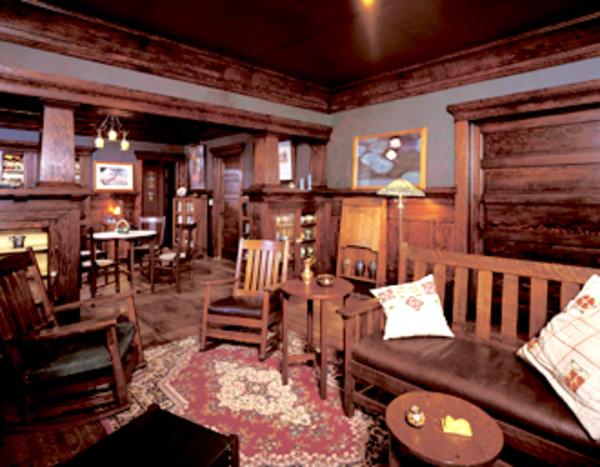
Restraint was the universal cry of good taste. Clutter was out—“clutter” being a relative term. Pottery, Indian baskets, Chinese and Japanese wares, vases, and Arts & Crafts hangings were suggested to satisfy the collector instinct. More affluent households might display Rookwood pottery, small Tiffany pieces, hammered copper bowls, and decorative items from Liberty and Co. A watercolor landscape or two, executed by the amateur painter of the family, was the ultimate Arts & Crafts expression for the home.







